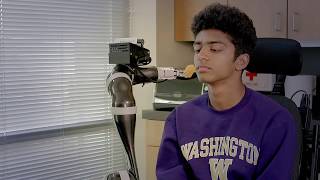NEWS
Robotic arm feeds people with a fork

Engineers from the University of Washington have developed an algorithm for a robotic system that can independently feed people with impaired mobility of hands.
In their report at the 2018 NeurIPS conference, scientists report that in order to understand how people handle food while eating, and adapting these actions for robots, the developers asked the research participants to feed the dummy. Analysis of the collected tactile signals and motion indicators helped to create an algorithm for the Kinova JACO robotic manipulator. The robot is mounted on a wheelchair and equipped with a gripper and a depth camera. The control unit with sensors controls the operation of the robot, during which the robotic arm picks up a fork, punctures fruits or vegetables on it and approaches the human mouth.
The developers note that the algorithm of the movements of such a robot depends on what kind of food it needs to work with. In the presentation, the robot is programmed to impale vegetables and fruits on a fork, while the movements of the manipulator depend on the specific type of food: soft and hard fruits are rotated by the robot from different angles. Also, the robot brings food to the operator's mouth at a convenient angle if the piece is too large or has an irregular shape.





